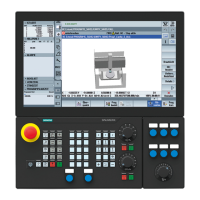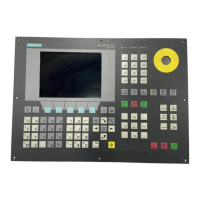Procedure
1. You can copy the sample le " oem_slck_deu.ts" from the following directory: /siemens/
sinumerik/hmi/template/lng.
2. Store or create the le in the /oem/sinumerik/hmi/lng or
/user/sinumerik/hmi/lng directory.
3. Give the le a name, e.g. for German texts: "slck_deu.ts".
If you wish to create the key labeling for additional languages, then a separate le must be
created for each language. Save the le with the appropriate language code in the le name.
To do this, use the language codes specied above.
4. Open the le and in the <message> and </message> area, dene the key labeling.
5. Restart the HMI.
In order that the key labeling is displayed during the program runtime, the le must be
converted into a binary format. This conversion is only executed when the HMI powers up.
Example of a key label
<!DOCTYPE TS><TS>
<context>
<name>SlCkDialog</name
<message>
<source>SK_USERKEY1</source>
<comment></comment>
<translation>U1</translation>
<remark>User key 1</remark>
<chars>10</chars>
<lines>2</lines>
<languageIndependent>true</languageIndependent>
</message>
<message>
<source>SK_USERKEY2</source>
<comment></comment>
<translation>U2</translation>
<remark>User key 2</remark>
<chars>10</chars>
<lines>2</lines>
<languageIndependent>true</languageIndependent>
</message>
<message>
.....
</message>
</context>
</TS>
Commissioning
8.1SINUMERIK Operate
Handheld Terminal HT 8
Equipment Manual, 02/2024, A5E52918633B AA 121

